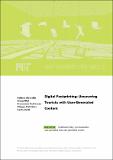Digital Footprinting: Uncovering Tourists with User-Generated Content
Author(s)
Girardin, Fabien; Blat, Josep; Calabrese, Francesco; Dal Fiore, Filippo; Ratti, Carlo
Download2008_Girardin_Blat_Calabrese_DalFiore_Ratti_IEEE.pdf (3.320Mb)
PUBLISHER_POLICY
Publisher Policy
Article is made available in accordance with the publisher's policy and may be subject to US copyright law. Please refer to the publisher's site for terms of use.
Terms of use
Metadata
Show full item recordAbstract
Novel methods and tools are being developed to explore the significance of the new types of user-related spatiotemporal data. This approach helps uncover the presence and movements of tourists from cell phone network data and the georeferenced photos they generate. A city's visitors have many ways of leaving voluntary or involuntary electronic trails: prior to their visits, tourists generate server log entries when they consult digital maps or travel Web sites; during their visit, they leave traces on wireless networks whenever they use their mobile phones; and after their visit, they might add online reviews and photos. Broadly speaking then, there are two types of footprint: active and passive. Passive tracks are left through interaction with an infrastructure, such as a mobile phone network, that produces entries in locational logs; active prints come from the users themselves when they expose locational data in photos, messages, and sensor measurements. In this article, we consider two types of digital traces from Rome, Italy: georeferenced photos made publicly available on the photo-sharing Web site Flickr and aggregate records of wireless network events generated by mobile phone users making calls and sending text messages on the Telecom Italia Mobile (TIM) system.
Date issued
2008-10Department
Massachusetts Institute of Technology. Department of Urban Studies and PlanningJournal
IEEE Pervasive Computing
Publisher
Institute of Electrical and Electronics Engineers
Citation
Girardin, F. et al. “Digital Footprinting: Uncovering Tourists with User-Generated Content.” Pervasive Computing, IEEE 7.4 (2008): 36-43. © 2008 Institute of Electrical and Electronics Engineers
Version: Final published version
Other identifiers
INSPEC Accession Number: 10289485
ISSN
1536-1268
Keywords
information visualization, pervasive user-generated content, reality mining